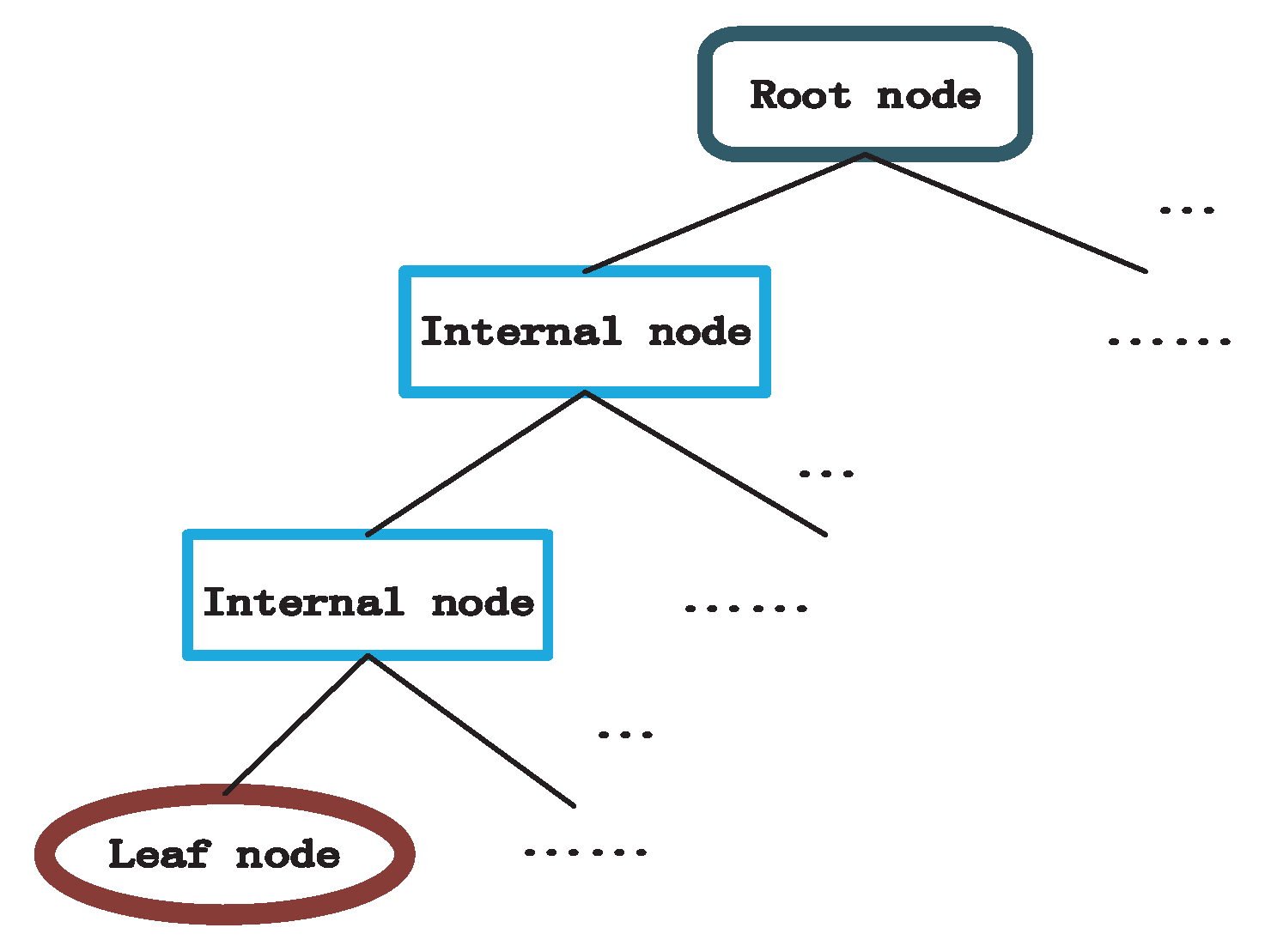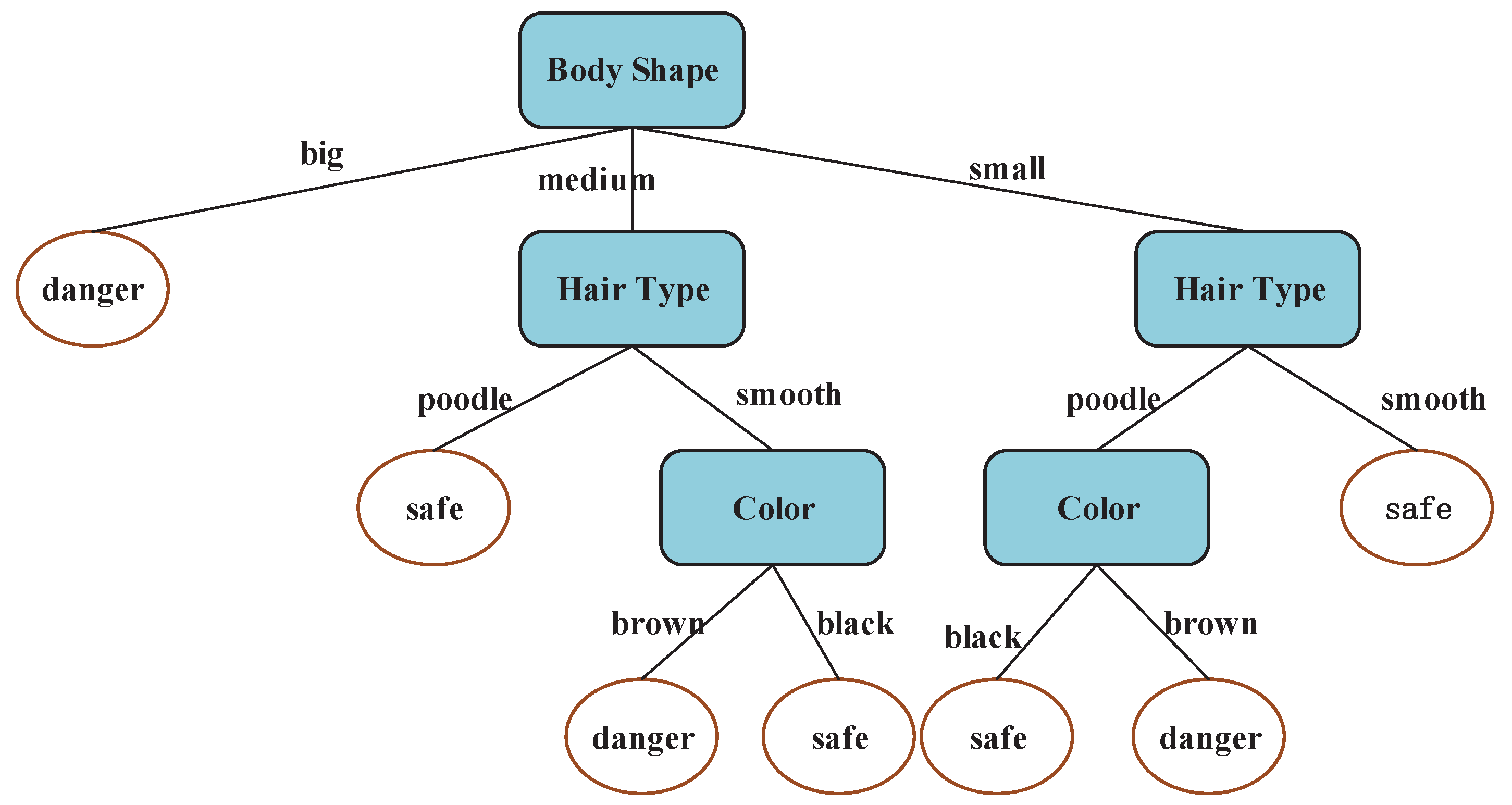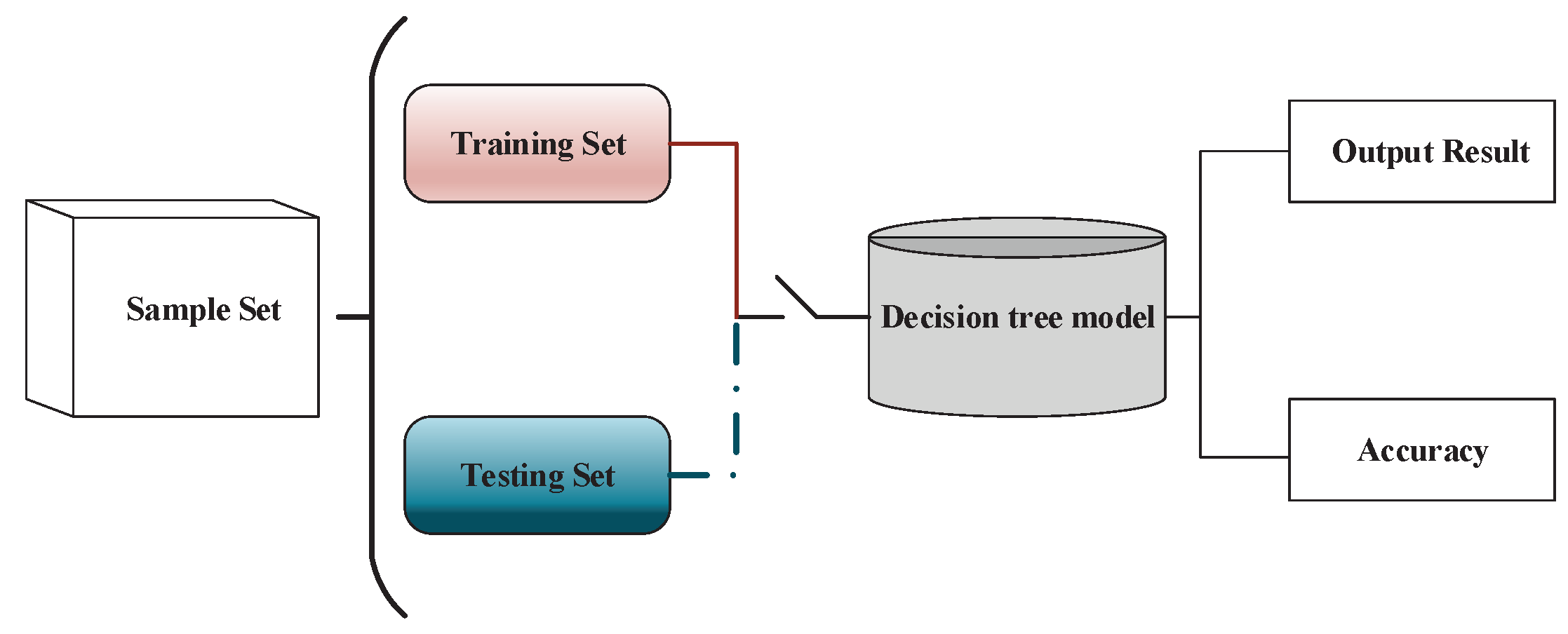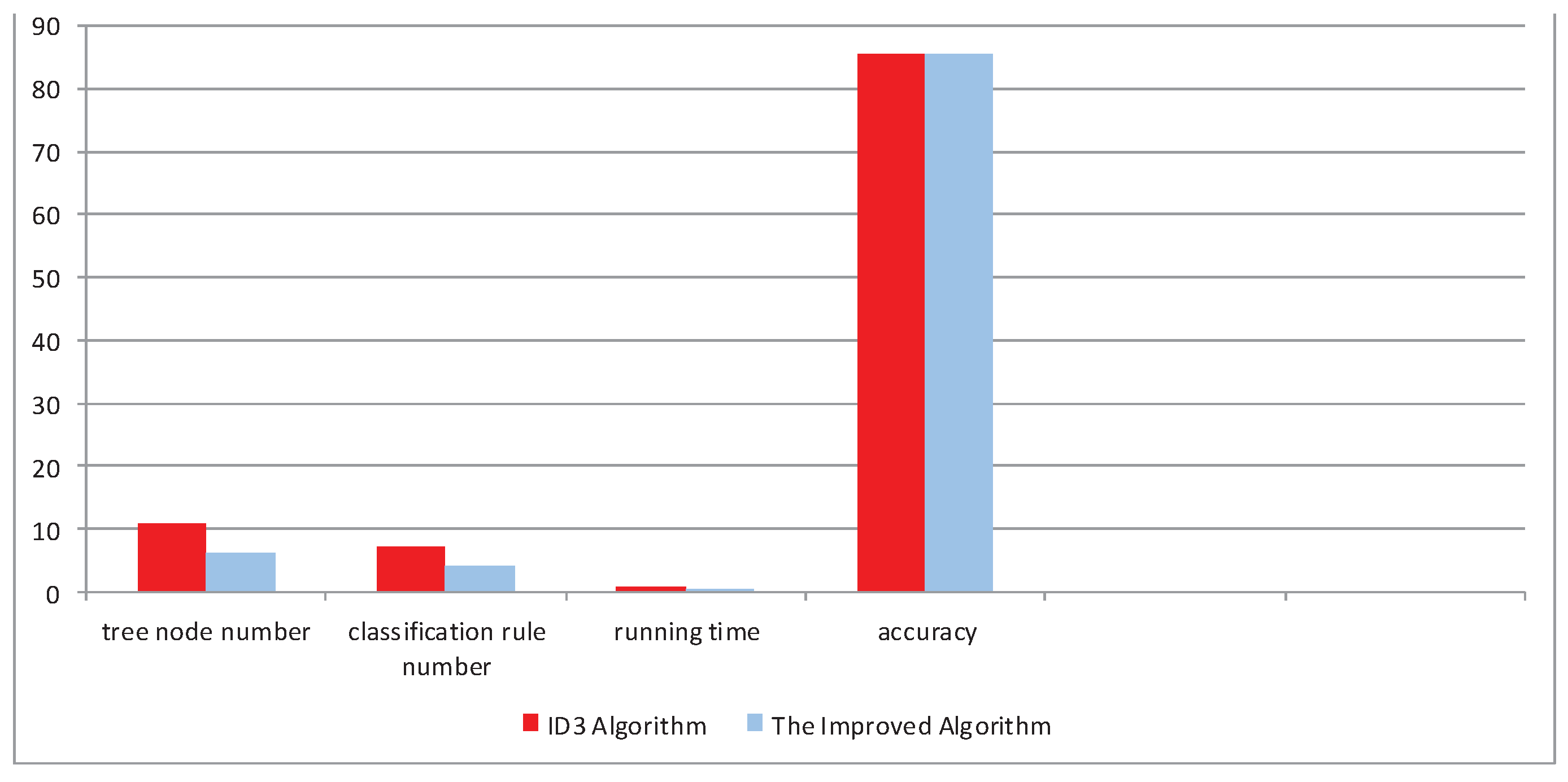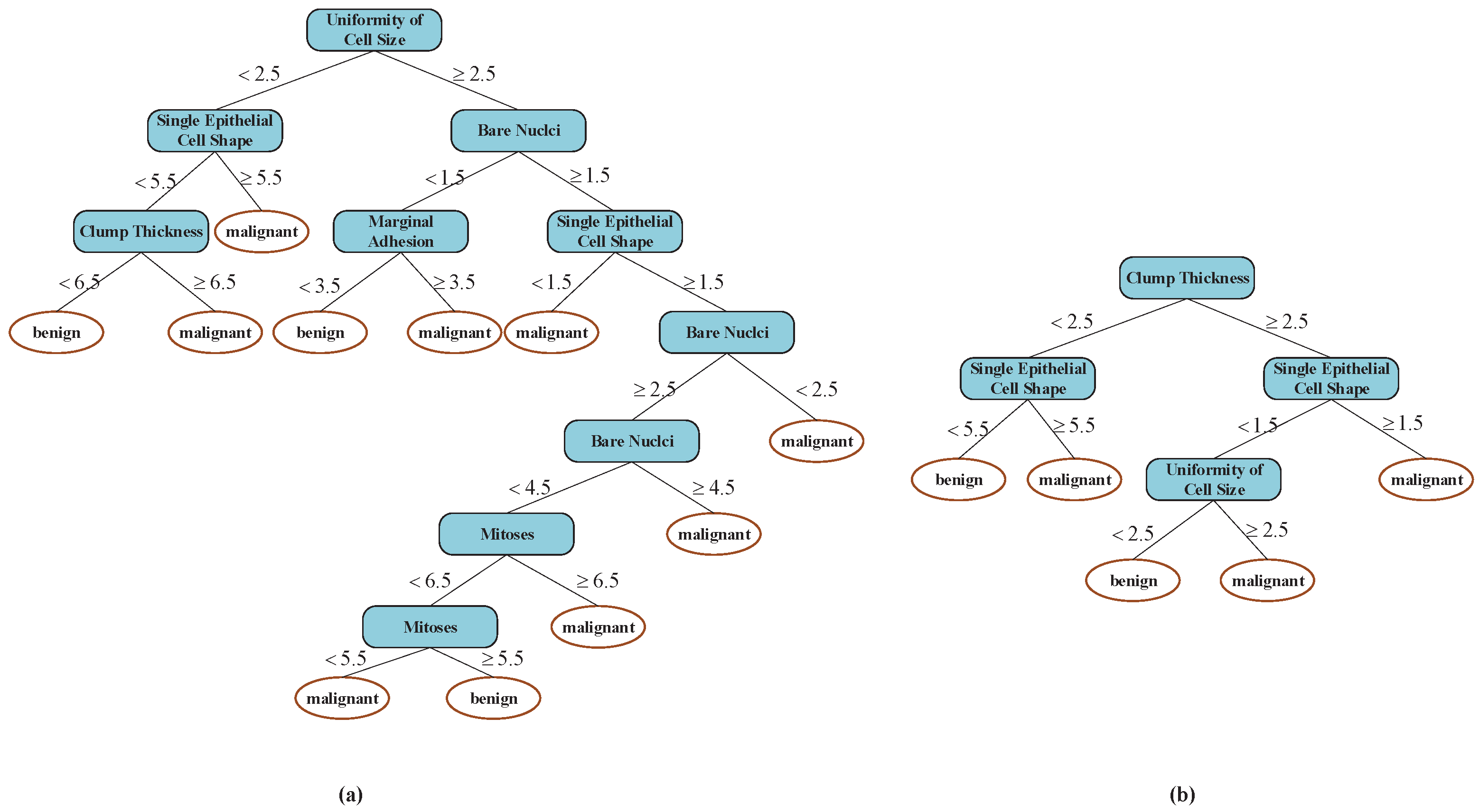1. Introduction
Large amount of data that includes a lot of potential and valuable information is stored in a database. If a wealth of hidden information can be extracted from the database, more potential value will be created. Faced with the challenge of the above issue, data mining [
1,
2] technologies came into being and showed strong vitality. Data mining includes several important technologies such as classification [
3], clustering [
4], regression [
5], etc. The classification mining technology, among data mining technologies, is becoming a most active and mature research direction allowing for successful applications. Classification mining [
6] can be applied to discover useful information from large amounts of data stored in a large number of fields such as hospital, stock, banking, etc. For example, it is important for a hospital to accurately predict the length of stay (LOS), and Ref. [
7] showed that the classification mining technology was not only beneficial to solve limited bed resources, but was also helpful for the hospital staff to implement better planning and management of hospital resources. In Ref. [
8], in order to easily acquire stock returns in the stock market, different classifiers were used in the stock market prediction, and the prediction accuracy was commonly satisfied. Ref. [
9] used two types of classifier ensembles to predict stock returns. The problem of bank note recognition is very important for bank staff. Ref. [
10] presented neuro-classifiers to address the big problem. Ref. [
11] presented the ANN classification approach, which could be used to detect early warning signals of potential failures for banking sectors.
The decision tree methods [
12,
13], the neural network methods [
14] and the statistical methods [
15,
16] are common classification algorithms used by researchers in the field of classification mining. A large amount of decision tree algorithms such as Iterative Dichotomizer 3 (ID3) [
17], C4.5 [
18], and Classification And Regression Tree (CART) [
19] are used in different fields. Most decision tree methods are developed from the ID3 method. For example, the C4.5 method [
20] presented an optimal attribution selection standard (gain ratio) [
21] instead of the optimal attribution selection standard (information gain) in ID3; The CART method took the Gini index [
22] as the selection standard of the optimal attribution. Although many advantages are acquired from these improved decision tree methods, there is also much room for improvement.
The ID3 algorithm is used as a general classification function, and it has many advantages, such as understandable decision rules and the intuitive model. Nevertheless, ID3 also has some disadvantages, for example: (1) there exists a problem of multi-value bias in the process of attribute selection [
23], but the attribution that has more values is not always optimal; (2) it is not easy to calculate information entropy [
24,
25] by using logarithmic algorithms, which costs a lot of time; and (3) the tree size is difficult to control [
26], and the tree with a big size requires many long classification rules.
In order to solve the problems above, an optimized scheme is proposed here based on the ID3 method. First of all, in order to solve the defect of multi-value bias brought by the information gain equation in ID3, C4.5 selected gain ratio instead of the information gain equation, but this method included a lot of logarithmic operations, which will affect the whole performance. This paper presents a novel method by directly adding different weights for the information gain equation of every candidate attribution, and this way not only makes the selection of the optimal attribute more reasonable, but also has a small effect on the running speed. Secondly, as we all know, in two equivalent formulas (e.g., the logarithmic expression and the four arithmetic operation), the computation speed of the logarithmic expression is slower than that of the four arithmetic operations that only include add, subtract, multiply and divide [
27]. Hence, this paper changes the logarithmic expression of the information gain of ID3 into the form of the four arithmetic operations by introducing the Taylor formula for developing in real time. Thirdly, this paper introduces coordination degree [
28,
29] in rough set theory [
30] to control the decision tree size by one step because most current decision tree methods take the pruning strategy to simplify the tree structure, which can complete the whole process in two steps. Finally, this paper proposes a new method to build a more concise and reasonable decision tree model with lower computational complexity. The experiment results finally shows that the proposed algorithm gets better performance than ID3.
The rest of this paper is organized as follows:
Section 2 describes steps of building a decision tree based on an ID3 algorithm as well as some advantages and disadvantages about the ID3 algorithm.
Section 3 addresses some drawbacks of the ID3 method by the proposed algorithm, which combines simplified information entropy with coordination degree in rough set theory.
Section 4 presents the assessment algorithm used in this paper. In
Section 5, differences between the traditional ID3 algorithm and the proposed algorithm are compared and analyzed through experiments. Final comments and conclusions are provided in
Section 6.
2. ID3 Algorithm Description
ID3 algorithm, the traditional decision tree classification algorithm, was presented by Ross Quinlan [
31] in 1986. ID3 makes use of information gain as an attribute selection method. The main structure of building a decision tree based on ID3 algorithm is summarized in Algorithm 1.
| Algorithm 1: ID3 algorithm |
| Input: Training set |
| Attribute set |
| Output: a decision tree |
| 1 Generate nodee |
| 2 If samples in D belong to the same class. Then |
| 3 The node is labeled as class C leaf node; Return |
| 4 End if |
| 5 If or the values in A are same in D, Then |
| 6 The node is labeled as leaf node; Return |
| 7 End if |
| 8 Maximum Information Entropy is chosen as a heuristic strategy to select the optimal splitting attribute from A; |
| 9 For every value in do |
| 10 Generate a branch for node; is the sample subset that has value from in D |
| 11 If is empty. Then |
| 12 The branch node is labeled as a leaf node; Return |
| 13 Else |
| 14 Take Tree Generate as the node that can continue be divided |
| 15 End if |
| 16 End for |
Let us introduce some notations. Information entropy and information gain are defined by:
where
stands for the training sample set, and
represents the number of training samples.
denotes the attribute set of
, and
.
stands for the probability that a tuple in the training set
S belongs to class
. A homogenous data set consists of only one class. In a homogenous data set,
is 1, and
is zero. Hence, the entropy of a homogenous data set is zero. Assuming that there are
V different values (
) in an attribute
,
represents sample subsets of every value, and
represents the number of current samples.
The decision tree model, a tree chart depicted in
Figure 1, can be acquired with the ID3 method described in Algorithm 1, and the decision tree model generally includes one root node, a number of internal nodes and some leaf nodes, where the root node represents the whole sample set, an internal node represents an attribute, and a leaf node represents a class label. The path from root node to every leaf node corresponds to a determine sequence.
There are many advantages [
32] to classify a mass of data by using the ID3 algorithm, such as strong intuitive nature, easy decomposability and so on, but the ID3 algorithm also has some disadvantages, for example:
- (1)
When using the information gain as attribute selection method, ID3 tends to choose the attribute that has more values [
33] because the value of the information gain equation of this type of attribution will be larger than that of others.
- (2)
As is known to all, if the logarithmic expression and the four arithmetic operations are the two equivalent expressions of one function, the running time of the four arithmetic operations is faster than that of the logarithmic expression [
34]. In the ID3 method, there are many logarithmic computations in the optimal attribution selection process, which will waste much time to calculate the information gain. If the logarithmic expression is changed by the four arithmetic operations, the running time in the whole building tree process will improve rapidly.
- (3)
It is hard to control the tree size in the process of building a decision tree. At present, most improved methods take pruning methods [
35] to avoid over-fitting phenomena, which will lead to the whole process of building decision tree models finished in two steps (i.e., modeling and pruning). If a concise decision tree is built in one step, this will save much time.
The intent of the paper is to solve the drawbacks that are mentioned above and propose an improved method to build the decision tree model. The improved ID3 algorithm is designed to generate a more concise decision tree model in a shorter time, and to choose a more reasonable optimal attribute in every internal node.
6. Conclusions
This paper proposed an improved ID3 algorithm, in which the information entropy equation that includes addition, subtraction, multiplication, and division firstly replaced the original information entropy expression that includes complicated logarithm operation in the ID3 method for economizing large amounts of running time, and then different weight values are respectively added to the new information entropy expression of each attribution for overcoming the multi-value bias problem in the ID3 method. Finally, the coordination degree is introduced to control the splitting degree of each internal node for building a more concise decision tree. The results of these experiments clearly indicate that the new algorithm in this study leads to less running time, shorter decision rules and higher predictive accuracy than those of the ID3 algorithm.
For future work, we will study how to build classifiers for dynamic data samples because they are more common than static samples in our life. We will also study how to choose a more efficient assessment method for reasonably assigning the training set and the testing set in view of its importance to the predictive accuracy of the decision tree model.
